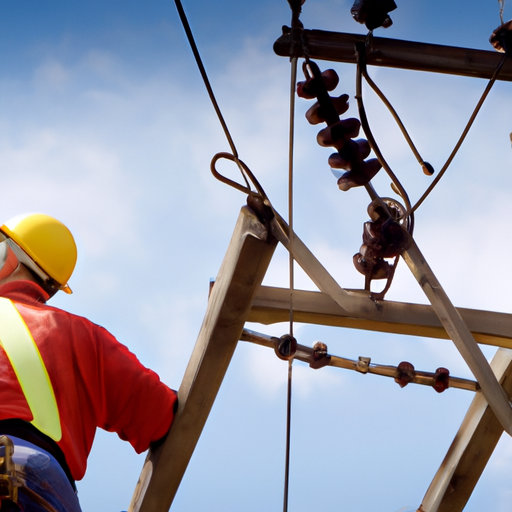In this article, you will learn about 10 essential lineman safety tips that can help keep you safe on the job. These tips are important for anyone working as a lineman or in a similar field, as they can help prevent accidents and injuries. By following these guidelines, you can ensure that you are doing everything you can to stay safe while working as a lineman.
First and foremost, it is important to always wear the appropriate safety gear. This includes a hard hat, protective eyewear, gloves, and proper footwear. Additionally, it is crucial to stay alert and focused while on the job, as any distractions or lack of attention can lead to accidents. Another important tip is to follow all safety protocols and procedures, and to communicate with your team members effectively. By following these safety tips and being mindful of your surroundings, you can greatly reduce the risk of incidents while working as a lineman.
Introduction
When it comes to working as a lineman, safety should always be a top priority. Linemen are exposed to various hazards and risks on a daily basis, and it is crucial to take necessary precautions to ensure their well-being. In this article, we will discuss ten essential lineman safety tips that can help prevent accidents and injuries. By following these tips, you can create a safer work environment and protect yourself and your colleagues from potential dangers.
Tip 1: Wearing Proper Safety Gear
Importance of wearing a hard hat
One of the most important safety measures for a lineman is wearing a hard hat. A hard hat is designed to protect your head from falling objects or impacts. It acts as a barrier between your head and any potential hazards, such as tools or debris that may be dislodged while working. Always make sure your hard hat fits properly and is in good condition to provide maximum protection.
Using safety glasses and face shields
Your eyes are extremely vulnerable to injuries while working as a lineman. Flying debris, sparks, or chemicals can cause significant damage if they come into contact with your eyes. Wearing safety glasses or face shields can provide essential protection against these hazards. Invest in high-quality protective eyewear that is resistant to impact, scratching, and fogging for optimal safety.
Importance of high visibility clothing
Linemen often work in outdoor environments and are at risk of being struck by moving vehicles or equipment. Wearing high visibility clothing, such as reflective vests or jackets, can greatly increase your visibility to others. This ensures that you are easily spotted, even in low light conditions. Always wear high visibility clothing whenever you are working in areas where there is vehicular traffic or equipment movement.
Wearing fall protection equipment
Working at heights is a common aspect of a lineman’s job, and falls from elevated surfaces can have severe consequences. To prevent such accidents, it is crucial to wear fall protection equipment, such as safety harnesses and lanyards. These devices are designed to arrest falls and distribute the impact force, reducing the risk of injury. Make sure to inspect your fall protection equipment regularly and replace any worn-out or damaged components.

Tip 2: Using Safety Equipment and Tools
Inspecting and maintaining tools regularly
Proper maintenance of tools is crucial to ensure their safe and efficient operation. Regularly inspecting your tools for signs of wear, damage, or malfunction can help prevent accidents caused by faulty equipment. Replace any damaged or worn-out tools immediately to avoid the risk of electrical or mechanical failures. Additionally, ensure that you are using the right tools for the job to maintain safety and efficiency.
Using voltage detectors and testers
When working with electrical systems, it is essential to identify the presence of voltage before making any connections or repairs. Voltage detectors and testers are invaluable tools that help determine if a circuit is live or de-energized. Always use these tools to verify the absence of voltage before performing any work on electrical systems. Never assume that a circuit is de-energized without proper testing, as this can lead to severe injuries or even fatalities.
Importance of using insulated tools
Insulated tools are designed to provide an extra layer of protection against electrical shocks. When working on live electrical systems, it is crucial to use insulated tools to minimize the risk of accidental contact with energized components. Insulated tools have specially designed handles and coatings that prevent electrical current from passing through them. Always use insulated tools when working on or near live electrical equipment.
Using proper grounding techniques
Proper grounding is essential to prevent electrical shock and ensure the safe operation of electrical systems. When working on electrical equipment, make sure to use proper grounding techniques such as connecting equipment to a grounded conductor or installing a grounding rod. This helps divert excess electrical current to the ground, reducing the risk of electric shock or fire. Familiarize yourself with proper grounding procedures and always follow them to maintain a safe working environment.
Tip 3: Following Lockout/Tagout Procedures
Understanding the lockout/tagout procedures
Lockout/tagout procedures are essential to ensure the safety of personnel working on energized equipment. These procedures involve isolating and de-energizing equipment, then securing it with locks or tags to prevent accidental energization. It is crucial to understand and follow lockout/tagout procedures to avoid electrical shock or other serious accidents. Always verify that equipment is de-energized and properly locked or tagged out before starting any maintenance or repair work.
Importance of de-energizing equipment before maintenance
Before performing any maintenance or repair work on electrical systems or equipment, it is vital to de-energize them. De-energizing involves shutting down the equipment and verifying that no electrical power is present. This ensures that you can work on the equipment safely without the risk of electrical shock or electrocution. Never attempt to work on energized equipment unless you are a qualified professional following specific procedures.
Properly tagging equipment to prevent accidental energization
Tagging equipment is an important step in the lockout/tagout process. Tags provide a clear visual indication that equipment is undergoing maintenance or repair and should not be energized. Always use appropriate tags that include relevant information such as your name, contact information, and the reason for the lockout/tagout. Clearly display the tags in a visible location to ensure that others are aware of the ongoing work and the associated hazards.

Tip 4: Working Safely with Electricity
Identifying electrical hazards
As a lineman, you will frequently encounter electrical hazards in your work environment. It is essential to develop a keen eye for identifying these hazards to prevent accidents and injuries. Look out for exposed wires, damaged insulation, overloaded circuits, or any other signs of electrical danger. If you notice any hazardous conditions, report them to the appropriate authority and take necessary precautions to stay safe.
Importance of proper grounding techniques
Proper grounding is crucial for the safe operation of electrical equipment. Grounding helps channel excess electrical current to the ground, preventing electrical shock or equipment damage. Always ensure that the equipment you are working on is properly grounded before performing any work. Grounding also provides a path of least resistance in case of electrical faults, diverting the fault current away from personnel and preventing potential injuries.
Using effective insulation methods
Insulation plays a vital role in protecting you from electrical shock or burns. Ensure that all electrical conductors and wires are properly insulated to prevent accidental contact with energized parts. Check for any signs of damaged insulation, such as cracks or exposed wires, and replace them immediately. Proper insulation can significantly reduce the risk of electrical accidents and create a safer work environment.
Importance of maintaining safe distances from live wires
When working with live electrical wires, it is crucial to maintain a safe distance to prevent accidental contact. Always follow the recommended safety distances specified in electrical regulations and guidelines. Use insulated tools or appropriate equipment to handle wires safely from a distance whenever possible. Never underestimate the potential dangers posed by live wires, and take every necessary precaution to avoid accidents.
Tip 5: Establishing a Safe Work Environment
Clearing the workspace from any potential hazards
Before starting any work, ensure that the workspace is clear from any potential hazards. Remove any debris, tools, or equipment that may pose a tripping or falling hazard. Keep pathways and walkways free from obstructions to ensure easy movement and prevent accidents. Regularly inspect the work area for any new hazards and address them promptly.
Properly organizing tools and equipment
An organized workspace is not only more efficient but also safer. Properly organize your tools and equipment to minimize the risk of accidents, such as falling objects or misplaced tools. Use designated storage areas or toolboxes to keep everything in its place. This not only reduces the chances of injuries but also saves time by allowing you to locate your tools quickly when needed.
Maintaining a clutter-free and well-lit workspace
A clutter-free workspace is essential for maintaining safety. Avoid leaving unnecessary items lying around and ensure that cables or cords are properly secured. This reduces the risk of tripping or falling accidents and allows for easier movement. Additionally, ensure that your workspace is well-lit to improve visibility and minimize the chances of accidents caused by poor lighting conditions.
Tip 6: Practicing Proper Climbing Techniques
Using the three-point contact rule while climbing
Climbing is a common task for linemen, and it is crucial to use proper climbing techniques to prevent falls. Always adhere to the three-point contact rule, which means that at least three limbs (hands and feet) should be in contact with the structure at all times while climbing. This ensures stability and reduces the risk of slipping or losing balance. Never rush while climbing and always maintain a secure grip to minimize the chances of accidents.
Wearing appropriate climbing gear and equipment
When climbing, it is vital to wear appropriate gear and equipment to ensure safety. Invest in high-quality climbing belts or harnesses that provide secure support and distribute body weight evenly. Check your climbing gear regularly for any signs of wear or damage, and replace them if necessary. Additionally, use climbing shoes or boots with non-slip soles to maintain a firm grip on the structure.
Importance of regular climbing practice and training
Climbing skills require regular practice to maintain proficiency and ensure safety. Engage in regular climbing practice to improve your climbing techniques, agility, and stamina. Stay updated on the latest industry standards and guidelines for climbing safety. Participate in training programs or workshops that provide hands-on experience and knowledge in safe climbing practices.
Tip 7: Implementing Effective Communication
Importance of clear and concise communication
Clear and concise communication is crucial in ensuring a safe work environment. Effective communication helps relay important information, instructions, and warnings to team members, reducing the risk of misunderstandings or accidents. Always use clear and simple language when conveying messages or instructions. Be attentive and responsive while communicating and encourage open dialogue among team members.
Using hand signals and radio communication
In an environment where verbal communication may be challenging or restricted, hand signals and radio communication play a vital role. Establish a set of standard hand signals that all team members are familiar with to convey messages, warnings, or instructions. Utilize radios or other communication devices to maintain constant contact with team members, especially when working at greater distances or in areas with limited visibility.
Regularly updating team members about work status
Regular updates about work progress and status are essential for maintaining safety and coordination among team members. Keep everyone informed about ongoing tasks, potential hazards, or any changes in plans. Provide clear instructions and ensure that everyone understands their roles and responsibilities. Regular communication helps enhance situational awareness and prevents misunderstandings that could lead to accidents.
Tip 8: Being Aware of Environmental Hazards
Identifying potential dangers in the surroundings
The work environment of a lineman can present various environmental hazards. It is essential to always be aware of your surroundings and identify potential dangers. Look out for uneven terrain, slippery surfaces, obstacles, or other hazards that may pose a risk. Take necessary precautions to eliminate or minimize these hazards, such as using barricades or warning signs.
Properly handling hazardous materials
Hazardous materials, such as chemicals or fuels, may be encountered during lineman work. It is crucial to handle these materials properly and adhere to all safety procedures and regulations. Familiarize yourself with the proper storage, handling, and disposal methods for hazardous substances. Always wear appropriate personal protective equipment (PPE) when working with or near hazardous materials.
Awareness of weather conditions and avoiding work in dangerous conditions
Weather conditions can greatly impact the safety of lineman work. Be aware of daily weather forecasts and assess the risks associated with specific conditions. Avoid working in extreme weather conditions, such as thunderstorms, heavy winds, or icy conditions, which can increase the chances of accidents or injuries. Prioritize your safety and seek shelter or reschedule work if necessary.
Conclusion
As a lineman, your safety should always be paramount. By following these ten essential lineman safety tips, you can greatly minimize the risk of accidents and injuries in your work environment. Remember to wear proper safety gear, use appropriate tools and equipment, follow lockout/tagout procedures, work safely with electricity, establish a safe work environment, practice proper climbing techniques, implement effective communication, and stay aware of environmental hazards. By prioritizing safety and consistently practicing good safety habits, you can create a safer work environment for yourself and your colleagues. Stay vigilant, stay safe!




